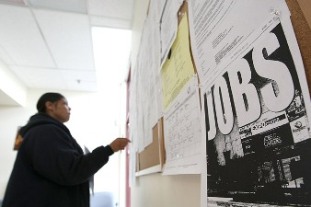
Jobless claims have bounced up and down over the past six months, but they have shown no overall improvement, according to data from the Labor Department. The latest weekly claims data matches the number of filings in the last week of December 2009.
Weekly claims typically would have to fall below 400,000 to signify improved hiring trends.
Economists surveyed by MarketWatch had expected initial claims for the week ended July 3 to fall to 458,000.
The four-week average of initial claims — a better gauge of employment trends than the volatile weekly number – fell 1,250 to 466,000.
Although claims tend to align with the economy over the longer term, the weekly data is prone to sharp fluctuations and is not directly tied to hiring trends.
What’s more, the data for July has usually been skewed by regularly scheduled shutdowns of major auto plants for retooling. Workers idled by those shutdowns are eligible to file for temporary jobless benefits.
“This is welcome news and we’d love to be able to say with confidence that it marks the start of a renewed downward trend, but we cannot,” Ian Shepherdson of High Frequency Economics wrote in an email. “The next clean claims data won’t appear until early August, so until then we are inclined to ignore the numbers.
The best indicator is the government’s report on job growth, but data for June released last week showed that hiring has basically come to a standstill in the past two months.
The lack of jobs and high level of unemployment, in turn, have become a central issue among voters and U.S. lawmakers as the fall congressional elections approach.
Meanwhile, the number of workers who continue to receive unemployment checks tumbled 224,000 to seasonally adjusted 4.41 million in the week ended June 26 – the latest data available.
In the week ended June 19, about 4.58 million jobless workers received extended federal benefits, down from 4.92 million. The figures are not seasonally adjusted.
Extended benefits are available to some workers after they use up eligibility for state unemployment compensation, which usually lasts 26 weeks. Congress has extended benefits for up to 99 weeks in the states hardest hit by the recession.
Yet the extension recently expired and Republicans have blocked Democratic efforts to renew it unless Congress cuts spending elsewhere in the budget.
As result, thousands of workers who have exhausted regular benefits are no longer receiving extra cash. The Labor Department estimates 3.3 million people could lose extended benefits by the end of July if they are not renewed.
Altogether, 8.97 million people were collecting some type of unemployment benefits in the week ended June 19. About 8.2 million Americans lost their jobs during the peak of the recession in 2008 and 2009 and many remain out of work.
At the end of June, the U.S. unemployment rate stood at 9.5%. It hit a 27-year high of 10.2% in the winter of 2009